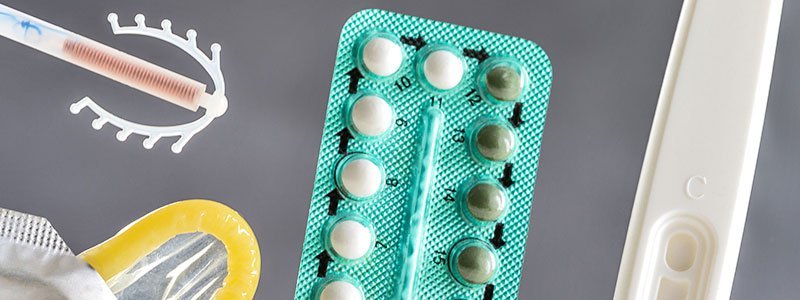What are birth control pills, and what are they used for?
Oral contraceptives (birth control pills) are medications that prevent pregnancy. They are one method of birth control.
Oral contraceptives are hormonal preparations that may contain combinations of the hormones estrogen and progestin or progestin alone. Combinations of estrogen and progestin prevent pregnancy by inhibiting the release of the hormones luteinizing hormone (LH) and follicle stimulating hormone (FSH) from the pituitary gland in the brain.
LH and FSH play key roles in the development of the egg and preparation of the lining of the uterus for implantation of the embryo. Progestin also makes the uterine mucus that surrounds the egg more difficult for sperm to penetrate and, therefore, for fertilization to take place. In some women, progestin inhibits ovulation (release of the egg).
3 birth control types
There are different types of combination birth control pills that contain estrogen and progestin that are referred to as monophasic, biphasic, or triphasic.
- Monophasic birth control pills deliver the same amount of estrogen and progestin every day.
- Biphasic birth control pills deliver the same amount of estrogen every day for the first 21 days of the cycle. During the second half of the cycle, the progestin/estrogen ratio is higher to allow the normal shedding of the lining of the uterus to occur.
- Triphasic birth control pills have constant or changing estrogen concentrations and varying progestin concentrations throughout the cycle. There is no evidence that bi- or triphasic oral contraceptives are safer or superior to monophasic oral contraceptives, or vice versa, in their effectiveness for the prevention of pregnancy.
What are the side effects of birth control pills?
The most common side effects of the birth control pills include;
- nausea,
- headache,
- breast tenderness,
- weight gain,
- irregular vaginal bleeding, and
- mood changes.
These side effects often subside after a few months of use.
Scanty menstrual periods or breakthrough bleeding may occur but are often temporary, and neither side effect is serious.
Women with a history of migraines may notice an increase in migraine frequency. On the other hand, women whose migraines are triggered by fluctuations in their own hormone levels may notice improvement in migraines with oral contraceptive use because of the more uniform hormone levels during oral contraceptive use.
Rarely, oral contraceptives may contribute to;
- increased blood pressure,
- blood clots,
- heart attack, and
- stroke.
Women who smoke, especially those over 35, and women with certain medical conditions, such as a history of blood clots or breast or endometrial cancer, may be advised against taking oral contraceptives, as these conditions can increase the adverse risks of oral contraceptives.
This is not a complete list of all side effects or adverse reactions that may occur from the use of this drug. Call your doctor for medical advice about serious side effects or adverse reactions. You may also report side effects or health problems to the FDA at 1-800-FDA-1088.
List of birth control pill brands and generic names
List of examples of oral contraceptives of different brands and categories:
| MONOPHASIC PRODUCTS | ||
| BRAND NAME(S) | ESTROGEN | PROGESTIN |
| Alesse-28 | ethinyl estradiol | levonorgestrel |
| Apri | ethinyl estradiol | desogestrel |
| Aviane | ethinyl estradiol | levonorgestrel |
| Brevicon | ethinyl estradiol | norethindrone |
| Demulen 1/35-21 Demulen 1/35-28 Demulen 1/50-21 Demulen 1/50-28 |
ethinyl estradiol | ethynodiol diacetate |
| Desogen | ethinyl estradiol | desogestrel |
| Genora 1/35 | ethinyl estradiol | norethindrone |
| Genora 1/50 | mestranol | norethindrone |
| Levlite 28 | ethinyl estradiol | levonorgestrel |
| Levlen 21 Levlen 28 |
ethinyl estradiol | levonorgestrel |
| Levora 0.15/30-21 Levora 0.15/30-28 |
ethinyl estradiol | levonorgestrel |
| Loestrin 21 1/20 Loestrin 21 1.5/30 Loestrin FE 1/20 Loestrin FE 1.5/30 |
ethinyl estradiol | norethindrone acetate |
| Lo-Ovral 28 Ovral 28 |
ethinyl estradiol | norgestrel |
| Low-Ogestrel 28 Ogestrel 0.5/50-28 |
ethinyl estradiol | norgestrel |
| Microgestin 1/20 Microgestin 1.5/30 Microgestin FE 1/20 Microgestin FE 1/5/30 |
ethinyl estradiol | norethindrone acetate |
| Modicon | ethinyl estradiol | norethindrone |
| Necon 0.5/35-21 Necon 0.5/35-28 Necon 1/50-21 Necon 1/50-28 Necon 1/35-21 Necon 1/35-28 |
ethinyl estradiol | norethindrone |
| Nordette 28 | ethinyl estradiol | levonorgestrel |
| Norinyl 1/50 | mestranol | norethindrone |
| Norinyl 1/35 | ethinyl estradiol | norethindrone |
| Nortrel 0.5/35 Nortrel 1/35 |
ethinyl estradiol | norethindrone |
| Ortho-Cept | ethinyl estradiol | desogestrel |
| Ortho-Novum 1/35 | ethinyl estradiol | norethindrone |
| Ortho-Novum 1/50 | mestranol | norethindrone |
| Ortho-Cyclen | ethinyl estradiol | norgestimate |
| Ovcon 50 Ovcon 35 |
ethinyl estradiol | norethindrone |
| Tri-Norinyl 28 | ethinyl estradiol | norethindrone |
| Yasmin 28 | ethinyl estradiol | drospirenone |
| Zovia 1/50E Zovia 1/35E |
ethinyl estradiol | ethynodiol diacetate |
| BIPHASIC PRODUCTS | ||
| BRAND NAME(S) | ESTROGEN | PROGESTIN |
| Jenest 28 | ethinyl estradiol | norethindrone |
| Mircette | ethinyl estradiol | desogestrel |
| Necon 10/11-21 Necon 10/11-28 |
ethinyl estradiol | norethindrone |
| Ortho-Novum 10/11 | ethinyl estradiol | norethindrone |
| TRIPHASIC PRODUCTS | ||
| BRAND NAME(S) | ESTROGEN | PROGESTIN |
| Estrostep 21 Estrostep FE |
ethinyl estradiol | norethindrone |
| Ortho-Novum 7/7/7 | ethinyl estradiol | norethindrone |
| Ortho Tri-Cyclen Ortho Tri-Cyclen LO |
ethinyl estradiol | norgestimate |
| Tri-Levlen 21 Tri-Levlen 28 |
ethinyl estradiol | levonorgestrel |
| Tri-Norinyl 28 | ethinyl estradiol | norethindrone |
| Triphasil 28 | ethinyl estradiol | levonorgestrel |
| Trivora 28 | ethinyl estradiol | levonorgestrel |
| 24-4 PREPARATIONS (24 days of hormone pills and 4 days of placebo pills) | ||
| Yaz | ethinyl estradiol | drospirenone |
| Lo Estrin 24-4 | ethinyl estradiol | norethindrone acetate |
| EXTENDED-CYCLE PREPARATIONS | ||
| Seasonale | ethinyl estradiol | levonorgestrel |
| Seasonique | ethinyl estradiol | levonorgestrel |
| PROGESTIN-ONLY PRODUCTS | ||
| BRAND NAME(S) | ESTROGEN | PROGESTIN |
| Micronor | norethindrone | |
| Nor-QD | norethindrone | |
| Ovrette | norgestrel | |
Previous contributing medical author: Carolyn Janet Crandall, MD, MS, FACP

SLIDESHOW
Sex-Drive Killers: The Causes of Low Libido See Slideshow
What is the dosage for birth control pills? How do you take them?
Many of the birth control pills come in easy-to-use dispensers in which the day of the week or a consecutive number (1, 2, 3, etc.) is written on the dispenser with a corresponding tablet for each day or number.
- For example, some Ortho-Novum dispensers are labeled “Sunday” next to the first tablet. Thus, the first tablet is to be taken on the first Sunday after menstruation begins (the first Sunday following the first day of a woman’s period). If her period begins on Sunday, the first tablet should be taken on that day.
- For birth control pills that use consecutive numbers, the first tablet (#1) is taken on the first day of the menstrual period (the first day of bleeding). Tablet #2 is taken on the second day and so on.
- Still other packages instruct women to begin on day five of the cycle. For such products, women count from day one of their menstrual cycle (day one is the first day of bleeding). On the fifth day, the first tablet is taken. Tablets then are taken daily.
- Most birth control pills are packaged as 21-day or 28-day units. For 21-day packages, tablets are taken daily for 21 days. This is followed by a seven-day period during which no birth control pills are taken. Then the cycle repeats.
- For the 28-day units, tablets containing medication are taken for 21 consecutive days, followed by a seven-day period during which placebo tablets (containing no medication) are taken.
- Newer formulations with 24 days of hormone pills and only four days of placebo pills are now available, as are continuous or extended-cycle oral contraceptive regimens, in which only active hormone pills are taken. Extended-cycle preparations include seven-day intervals of placebo pills to be taken approximately every three months.
- Women just starting to take birth control pills should use additional contraception for the first seven days of use because pregnancy may occur during this period.
- If women forget to take tablets, pregnancy may result. If a single tablet is forgotten, it should be taken as soon as it is realized that it is forgotten. If more than one tablet is forgotten, the instructions that come with the packaging should be consulted, or a physician or pharmacist should be called.
Latest Sexual Health News
Daily Health News
Trending on MedicineNet
What drugs interact with birth control pills?
Estrogens can inhibit the metabolism (elimination) of cyclosporine, resulting in increased cyclosporine blood levels. Such increased blood levels can result in kidney and/or liver damage. If this combination cannot be avoided, cyclosporine concentrations can be monitored, and the dose of cyclosporine can be adjusted to assure that its blood levels do not become elevated.
Estrogens appear to increase the risk of liver disease in patients receiving dantrolene (Dantrium) through an unknown mechanism. Women over 35 years of age and those with a history of liver disease are especially at risk.
Estrogens increase the liver’s ability to manufacture clotting factors. Because of this, patients receiving warfarin (Coumadin) need to be monitored for loss of anticoagulant (blood thinning) effect if an estrogen is begun.
Several medications, including some antibiotics and antiseizure medications, can decrease the blood levels of oral contraceptive hormones, but an actual decrease in the effectiveness of the oral contraceptive has not been convincingly proven. Nonetheless, because of this theoretical possibility, some physicians recommend backup contraceptive methods during antibiotic use. Examples of medications that increase the elimination of estrogens include
Birth control pills with higher concentrations of estrogen or alternative forms of contraception may be necessary in women using those medications.

QUESTION
Which of the following are methods for contraception? See Answer
Are birth control pills safe to take if you are breastfeeding?
Use of birth control pills during lactation has been associated with decreased milk production, decreased infant weight gain, and decreased nitrogen and protein content of milk. The amount of estrogen consumed by an infant whose mother takes a standard dose of birth control pills is considered to be the same as from a lactating woman who is not taking birth control pills, and side effects have not been reported.
Using a progestin-only product is most often recommended during lactation if birth control pills are to be used during this period. The American College of Obstetrics and Gynecology (ACOG) recommends delaying taking combined estrogen-progestin contraceptives until at least six weeks postpartum, while the World Health Organization (WHO) recommends delaying the initiation of combined contraceptives until six months.
How do you store birth control pills safely?
- All oral contraceptives should be stored in a safe place, out of the reach of small children, at a temperature between 15 C (59 F) and 30 C (86 F).
Subscribe to MedicineNet’s General Health Newsletter
By clicking Submit, I agree to the MedicineNet’s Terms & Conditions & Privacy Policy and understand that I may opt out of MedicineNet’s subscriptions at any time.
Medically Reviewed on 6/29/2022
References
REFERENCES:
FDA Prescribing Information